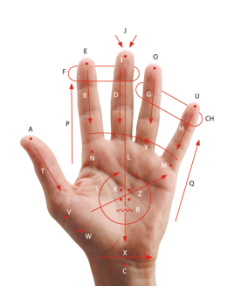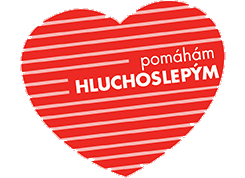Communication of Deafblind People
Method of communication with a deafblind person depends primarily on the extent of his/her disability, and also on the time disability emerged. Important influence on the quality of communication, understanding and listening has also environment, lighting, noise, weather, mental status, speaker´s pitch of voice, speech pattern, form and complexity of expression. People with congenital deafblindness and acquired total deafblindness need most attention.
The most commonly used communication systems of the deafblind include:
- Speech
- Written Form
- Sign Language
- Tactile Sign Language
- Lorm´s Alphabet
- Braille
- Block Letters Written in the Hand (Dactylography)
- Finger Alphabet (dactylotics)
- Dactylotics in the Palm
- Tadoma
- Lip-reading
Choice of individual communication systems is entirely individual, it depends on the time of emergency of disability, the prevailing sensory handicap, age, developmental level and the mental and physical condition of deafblind persons.
Tactile Sign Language
It is a touch variant of sign language, which is adapted to the communication possibilities of deafblind people. Tactile sign language is based on the mutual contact of one or both hands of the communicators. Tthe deafblind person receives information through the active tactile contact with singing hands. This form of communication is used by those deafblind, who first use sign language and later due to deteriorating visual perception are forced to move to its tactile form. While in the world is tactile sign language commonly used among deafblind people, in the Czech Republic it is spread by our project Development of tactile sign language.
Czech Version of Lorm’s Alphabet
The Czech modification of the original German Lorm’s alphabet was created by Czech deafblind people at their meeting organized by LORM society in June 1993.
For communication with a deafblind person we preferably use the palm of his left hand, with its fingers a little spread. When needed also the palm of the right hand might be used. The speaker uses mostly the tips of his index finger to point into the receiving person´s hand and fingers. The letters are set according to the following scheme.
Clicking on image will show you it’s larger version
A – touch the tip of the thumb
B – short strike downwards along his index finger in the direction from the tip in the middle of the finger
C – touch the wrist /touch the middle point of the lowest part of the palm of his hand.
D – short strike downwards along his middle finger in the direction from the tip in the middle of the finger
E – touch the tip of his index finger
F – gently squeeze together the tips of his index finger and his middle finger
G – short strike downwards along his ring finger in the direction from the tip in the middle of the finger
H – strike downwards along his little finger in the direction from the tip in the middle of the finger
CH – gently squeeze together the tips of the ring finger and the little finger
I – touch the tip of his middle finger
J – gently squeeze the tip of his middle finger
K – touch with all your tips together the middle of the palm of his hand
L – long strike downwards along his middle finger in the direction from the tip in the middle of the finger
M – touch the base of the little finger
N – touch the base of the index finger
O – touch the tip of the ring finger
P – long strike upwards on the outside (on the side to the thumb) of the index
Q – long strike upwards on the outside of his hand (on the side of the little finger)
R – drum slightly with several of your tips in the middle of the palm of the hand
S – circle in the middle of the palm of the hand
T – strike downwards in the middle of the thumb
U – touch the tip of the little finger
V – touch the thumb vault, somehow from the outside
W – touch the thumb vault twice, somehow from the outside, the second touch follows at the same spot after the first one
X – horizontal strike (from the thumb to the little finger) over the wrist
Y – horizontal strike (from the index finger to the little finger) over the bases of all the fingers
Ý – horizontal strike (from the index finger to the little finger) over the bases of all the fingers, ending with one perpendicular strike
Z – diagonal strike from the thumb to the base of the little finger (over the center of the palm)
Long wovels – A squeeze of the tip of the relevant finger for the vowel and continuously strike towards the tip of the finger, or a short strike on the tip of the relevant finger towards the tip of the finger.
Letters with wedges – The letters with wedges (Č, Ď, Ě, Ň, Ř, Š, Ť, Ž) are communicated by two following touches. Firstly the wedge is pointed by touching the curve between the thumb and the index finger and afterwards the letter itself is marked. For example the letter “Š” is communicated by touching the curve between the thumb and the index finger and afterwards the circle in the palm of the hand follows. The letter “Ě” is communicated by touching the curve between the thumb and the index finger and afterwards the touch at the tip of the index finger follows.
Numbers – Two possible ways: 1. Arabic numbers write by the outline in the palm of the hand, the marking of the numbers thousand, million and billion by abbreviations – tsd., mill. bill., 2. or using the same marking as in Braille’s writing: 1 = A, 2 = B, 3 = C, 4 = D, 5 = E, 6 = F, 7 = G, 8 = H, 9 = I, 0 = J, and before the letter use the reversed strike of “L” (from the wrist to the tip of the middle finger)
I don’t understand – Closing the palm.
Question mark – Write with your index finger the outlines of the question mark.
Space between words – A double strike by the open hand on the palm of the hand.
Error – A gentle clap to the palm of the hand.
Sentence ending – A double strike by the open hand on the palm of the hand.



